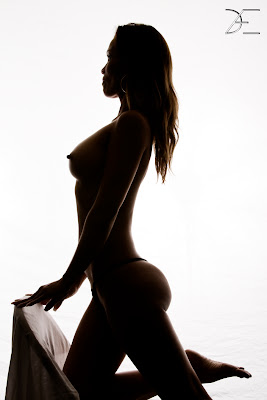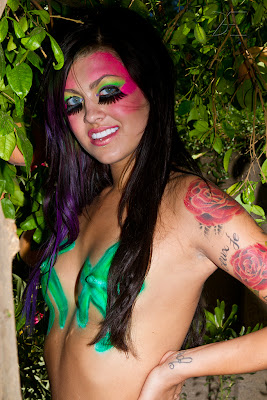 |
| Veronica Vaughn |
Pt. 1
I just finished processing images from a group photoshoot event I participated in about 2 weekends ago. This was the first event I had attended with this particular meetup group and I went to the event not knowing anything about how the shoots were run until I showed up at the door. Like most things in life there were positives and negatives I took from the event, but it made me think about the title question more seriously. I’ll address the particular event first, and then the question as a larger issue second.
 |
| Esmerelda |
The event was held in a San Francisco studio that clearly had been created as a near-permanent photostudio. This was the first time I had been in such a space, so seeing the 4 different set setups and additional set spaces available was astounding. There was more lighting and wiring equipment in that studio than I’m likely to ever have in my lifetime. That studio is capable of providing a plethora of lighting resources, so creativity should not be a problem for a prepared photographer.
 |
| Veronica Vaughn |
The organizers of the event were genuinely friendly and willing to talk about the shoot, the studio, life, etc., so time didn’t seem to drag on at any point during the day. Before the shooting started, the organizer explained the process to the photographers, stating that we’d have free run of 2 fashion sets (black or white backgrounds) , use of 1 of the glamour sets (pink background), and free use of the natural light area (open space in 2nd room of studio). He also explained the few rules: no touching, no entering the dressing room, no adjusting wiring, etc. He then explained that all of the models were aware of the shoot style (Italian-style Vogue Fashion), and that these would be edgier images than typical fashion but not glamour images.
 |
| Veronica Vaughn |
At this point, it is important to note that it did state in the meetup groups signup sheet that these were all newer models. This was evidenced by a model who, after dressing in some lingerie and walking onto the first set, immediately decided to quit and left without actually modeling. This forced the female organizer (a model herself) to have to step in so the model total would be back up to 4 models. As I still have no idea if the models were paid for this event, I don’t know if the quitter ended up costing the organizers any money or not. Either way, it was critical for this event to have 4 models because there ended up being ~11 photographers(not counting the male organizer who shot images, and the 2 late shows) at this event.
 |
| SamIAm |
Up to the present time, I have participated in several free-for-all style photoshoot meetups, and personally do not prefer them. That said, I have been in some that have ran better than others. While I’m not a full-time, career photographer, my impression is that photographers who are would probably not like free-for-all shoots if they intended to use the images for anything useful. The most obvious problem this creates is that the aesthetic biases(to put it politely) of the photographers always come up. One of the models in this fashion shoot was tall, pretty, and generously & naturally endowed. Her MM profile states she’s a D cup, but she is probably larger. As I happened to be into the room she walked into for her first set I was able to observe the flock of male photographers stream to shoot her. It went from 2 photographers in the room to 10 photographers clamoring over each other in less than a minute. I shot 2 images of her in that outfit then left to find another model to work with. In every free-for-all I’ve attended, the photographer shooting stampede has split the model’s attention in to many directions, impeded her ability to find a posing flow, and resulted in the model adopting canned modeling poses rather than really utilizing the wardrobe to the fullest extent. Consequently the photographers shoot quantity over quality and getting great images becomes mostly a crap shoot, rather than a definitive practice. Now I’ve seen highly skilled and experienced models rise above the melee; but that has only occurred as the photographer glut lost interest and moved to the next model or set so the number of shooters dropped down to less than 4.
 |
| Funz |
I’m traditionally a pretty laid-back shooter; I prefer to spend my energy preplanning what & how to shoot before the actual shoot date. I then take a “let’s see how it goes…” approach on the actual shoot date using the ideas and plans as catalyst or generation points for shooting. I am therefore not opposed to attending free-for-all events. I do however feel that these types of events shortchange models, unless they are compensated in money for modeling. A model serious about generating future work should know that he/she can’t have 25 images of the same wardrobe and from the same shoot in his/her portfolio. Such a port demonstrates a lack of range or experience in modeling. F-F-A shoots tend to provide a model a glut of these images. Yes he/she will have a pose from 10 different angles, but additional angles doesn’t automatically yield a superior picture. In many cases, poses only look good from particular locations so extra angles are just wasted shots.
A second concern for models should also be increasing the skill level through practice in a shoot. The ability to interact with a photographer to create the desired image is hampered when multiple photogs are shooting at the same time. However, if the photographers are new, or inexperienced, they may be incapable of shooting for a particular image and instead shoot-to-hope for something good.
 |
| Ranie Mae |
 |
| Ranie Mae |
At this particular Italian, vogue-style fashion event wardrobe was a big issue. I don’t know if the concept was clearly explained—with visual examples—to the models, but it was my impression that the majority of them did not come prepared for the type of shoot sold to the photographers. Showing up to a shoot with only 1 pair of underwear is not planning ahead. If a model states she is willing to do implied work, proper preparation would be arriving with 1 strapless bra and no thongs or panties. This was of particular interest to me as the models walked onto the sets already in their wardrobe and the photographers had no input as to what outfits (or how the outfits) were worn. The one model who actually had layered her wardrobe—allowing for staged removal of clothing items—came in more gothic-style wardrobe which none of the sets were set up for; this resulted in the wardrobe looking at odds with the shoots rather than complimenting the shoot.
 |
| Ranie Mae |
Moving away from the modeling end, I find as a photographer that F-F-A shoots do not yield me as high returns of quality images. When I’m firing on all cylinders(when conducting a solo photoshoot) my bad-to-excellent image ratio tends to hover around 12-to-1, and drops to 18-to-1 on my off days. I’ve never had a group F-F-A shoot that yielded me anything better than a 20-to-1 ratio. This is due to the dual confound of shooting less total images (I have to clamor over or compete with other photogs to shoot) and not having a flow with the model to shoot through many poses(I end up shooting what I can get, not what I’d like). The longer I’ve been in photography the stingier I’ve become with my time and energy. I see little benefit spending hours of time for useless images that don’t improve my skills nor improve my portfolio.
Today’s images are of silhouettes taken at a couple different times. I am wanting an opportunity to revist silhouette photography as I feel I’ve learned much about the photography style over the past 18 months. Hopefully my results for the MM casting I will put up will yield better results.
 |
| Ranie Mae |
 |
| Ranie Mae |
 |
| Ranie Mae |



























